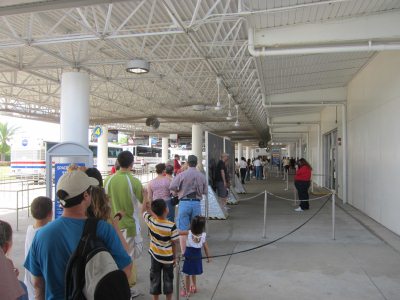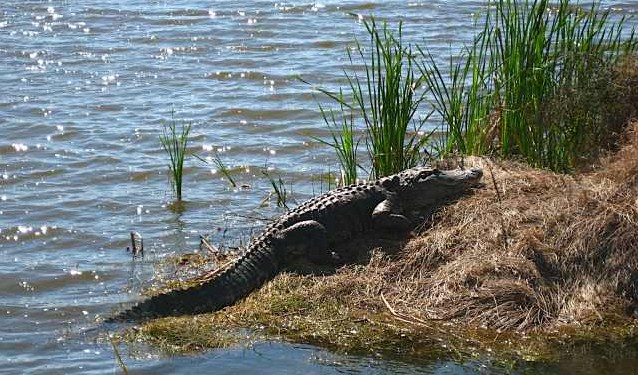KSC VAB and Wildlife Park

|
The Kennedy Space Centre Vehicle Assembly
Building
We were picked up by the hire car people at eight
thirty, as it is Easter Saturday they cannot pick the car up from the marina
tomorrow, so we get to keep our battered old Leon two days for the price of
one (or about eighteen pounds per day). We are an hour or so from Disney World
and only twenty minutes from the Kennedy Space Centre over the Nasa Causeway Bridge. The very bridge we came under
yesterday.
  Getting in was a very slick process, they are well
organised here to deal with enormous crowds. Soon helped by
very friendly staff, we waited a short while for one of the many buses
that move people around.
 Our first driver - George from New York, stopped to let
us take pictures of a snoozing alligator, not what we
had envisioned seeing, but as George pointed out; we are not only in a vast
complex, we are in a vast nature reserve, that is fully protected with many
wardens.
Merritt Island National Wildlife Refuge is an important U.S.
National
Wildlife Refuge on the Atlantic
coast of Florida.
It is also a 'gateway site' for the Great
Florida Birding Trail. Location and extent: Merritt Island National Wildlife Refuge is located due east of Titusville
on Merritt
Island in Brevard
County, Florida, and occupies 140,000 acres. To the north, it borders
on the Canaveral
National Seashore; to the south it borders on the Kennedy
Space Center (with which it also shares some history), which in turn
abuts Cape
Canaveral Air Force Station. Mosquito
Lagoon and the Indian
River run through the refuge. Since public access to all these areas
is controlled in various ways, the refuge is part of a very substantial area of
relatively undisturbed wildlife habitat. History: The land occupied by the NWR was acquired by NASA
in the early 1960’s for the development of the Space Center and its
non-operational purposes. Until that time there had been little development in
the area because of the high number of salt marsh mosquitoes.
Public access is normally permitted, and several state
highways run across the refuge; however, the public can be excluded
if necessary for NASA's purposes (for example, this is currently done in the
days before a space
shuttle launch or landing). Habitats and species: The refuge provides a range of habitats, from saltwater estuaries
and freshwater impoundments and marshes, to dunes,
hardwood
hammocks,
and scrub.
It is therefore rich in over 1000 species of plants, 117 species of fish,
68 amphibians
and reptiles,
330 birds
and 31 mammal
species. Of these species, 21 are listed as endangered
either by the state of Florida or by the US federal government. The following
are some of the more important species using the refuge; most of them nest
there: Sea
turtles including the Loggerhead
Sea Turtle and Green
turtle (there are about 4,000 nests on the beach each year). American
Alligator. Osprey.
Bald
Eagle. Many species of waterfowl
use the refuge as a wintering ground; Blue-winged
Teal and Northern
Shoveler are resident in small numbers. Many species of shorebirds,
some resident and some using the refuge in the course of their migration.
Several species of rails.
Anhinga.
Several species of heron
and egret.
Glossy
and White
Ibis. Roseate
Spoonbill. Florida
Scrub Jay. West
Indian Manatee. Florida
Panther, an endangered subspecies of Cougar
and the Dwarf
Siren, a recently discovered salamander.  Next he pointed out a Bald Eagle
nest. The pair have been happily nesting here for twenty two years. The
pair who mated for life don't spend the summer here but return each
fall.
 Time to watch two information videos before being
dropped at the shuttle viewing gantry. We passed the
VAB, not allowed in but George gave us time to take
pictures.
On our bus journey to the shuttle The Vehicle (originally Vertical) Assembly Building, or vee-ay-bee, is
located at NASA's Kennedy
Space Center (KSC). The building is at Launch
Complex 39 at KSC, halfway between Jacksonville and Miami, and due east of Orlando on Merritt
Island on the Atlantic coast of Florida. The VAB is the largest single-story building in the world, was the
tallest building in Florida until 1974 and is still the tallest building in the United States outside an
urban area. It is the fourth largest
building in the world by volume. History: The VAB was originally built to allow for the vertical assembly of the Saturn V rocket for the Apollo program. It is now used for housing Space Shuttle external fuel tanks and flight hardware and is the location of space shuttle orbiter mating (stacking) with the solid rocket boosters and external fuel tank, that combined makes up the complete Space Transportation System, called the Space Shuttle for short. Once assembled, the Space Transportation System is moved on the Mobile Launcher Platform and Crawler-Transporter to LC-39 Pad A. Construction: The VAB is 526 feet tall, 716 feet long and 518 feet
wide. It covers 8 acres and encloses 129,428,000 cubic feet of
space. The building has 10,000 pounds of air conditioning equipment including
125 ventilators on the roof supported by four large air handlers (four
cylindrical structures west of the building) to keep moisture under control. Air
in the building can be completely replaced every hour. The interior volume of
the building is so vast that it has its own weather, including "rain clouds form below the ceiling on very humid days", which the moisture reduction systems are designed to minimize. The
building was constructed to withstand hurricanes and tropical
storms with a foundation consisting of 30,000 cubic yards of concrete and
4,225 steel rods driven 160 feet into limestone bedrock. Capabilities: There are four entries to the bays located inside the building, which are the four largest doors in the world. Each door is 456 feet high and takes 45 minutes to completely open or close. The north entry that leads to the transfer aisle was widened by 40 feet, to allow entry of the orbiter. A central slot at the center of the north entry allows for passage of the orbiter's vertical stabilizer. To lift the components of the Space Transportation System, the VAB houses five overhead bridge cranes, including 2 capable of lifting 250 tons, and 136 other lifting devices.
 Exterior: The American
flag painted on the building was the largest in the world when it was
painted in 1976 as part of United
States Bicentennial celebrations, along with the star logo of the anniversary, later
replaced by the NASA
insignia in 1998. It is 209 feet high and 110 feet wide. Each of
the stars on the flag is 6 feet across, the blue field is the size of a
regulation basketball court, and each of the stripes is 9 feet wide, the width of a standard road lane.
Storm Damage: Work began in early 2007 to restore
the exterior paint on the immense facility. Special attention was paid to the
enormous American flag and NASA "meatball" insignia. The work repaired visible
damage from years of storms and weathering. The flag and logo had been
previously repainted in 1998 for NASA's 40th anniversary. The most extensive exterior damage occurred during the storm season
of 2004, when Hurricane
Frances blew off 850 14 × 6 foot aluminum panels from the building, resulting in about 40,000 square feet
of new openings in the sides. Twenty five additional panels were blown off the
east side by the winds from Hurricane
Jeanne just three weeks later. Earlier in the season, Hurricane
Charley caused significant but less serious damage, estimated to cost
$700,000. Damage caused by these hurricanes was still visible in 2007. Some of
these panels are "punch-outs", designed to detach from the VAB when a large
pressure differential is created on the outside vs. the inside. This allows for
equalization, and helps protect the structural integrity of the building during
rapid changes in pressure such as in tropical cyclones. Future: The Space Shuttle will be retired in 2011. Although the VAB would be used to some extent for assembly and processing of any future vehicles utilising Launch Complex 39, no such system has yet been identified.
 ALL IN ALL WHAT A SURPRISE WITH THE WILDLIFE AND WHAT A
BUILDING |
